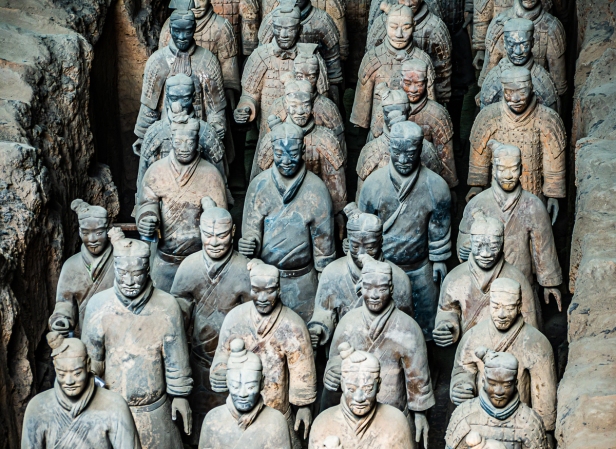
24-25 May 2018.
Once upon a time, about 2400 years ago, there were seven warring kingdoms in the place now known as China; everyone was fighting everyone and there was rarely peace in the land.
The kings of two of these dominions decided to make a peace pact. The King of Qin sent his son Yiren to live in the kingdom of Zhao. A precarious peace was then established between the two states.
With politicking and underhanded machinations, an influential merchant of Zhao helped Yiren get back to Qin. He also presented Yiren with his concubine who bore Yiren a son, Ying Zheng.
With the passing of time the King of Qin died, his heir apparent became king and then he too died. Finally it was Yiren’s turn. Yiren became King of Qin, and his son Ying Zheng was named as his crown prince. After reigning for just three years Yiren died, and at thirteen years of age, in 246 BCE Ying Zheng became King of Qin.
The final twist: some records indicate that Ying Zheng may actually have been the illegitimate son of the merchant. No wonder he went to such lengths to help Yiren get back to Qin, and onto the throne.
It is a story of secrets, lies, politics, and backroom deal-making to equal any found in all the royal courts and halls of power throughout history the world over. And yet it produced something of great significance: the unification of China.
It seems hard to believe, and no doubt with the help of a lot of generals and the like, but by the time Ying Zheng was thirty-eight, in 221 BCE, he had conquered all six of the other warring states, and proclaimed himself Emperor Qin Shi Huang Di – the First Emperor of Qin. He was the founder of the Qin dynasty, and the first emperor of unified China. The pronunciation of Qin is close to chin giving China its name.
Having proclaimed himself emperor he soon ordered the building of a great mausoleum to take care of his needs in the afterlife, in much the same way as the Egyptian pharaohs. It seems to me that a lot of these ancient powerful rulers had a peculiar preoccupation with the afterlife. Perhaps it was the only way they knew how to live on forever, so they wanted to take everything with them.
Nothing could have prepared me for my first sight of the terracotta warriors. I walk into the main hall, work my way through the crowd to the front of the railing surrounding the pit and look out over a vast sea of life-size clay soldiers. My jaw drops.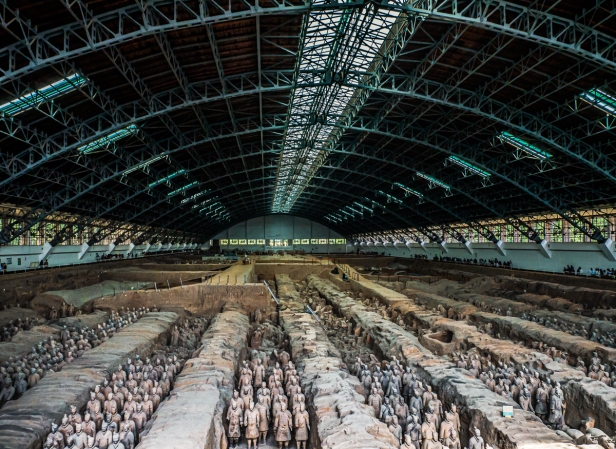
I’m in an enclosure that covers more than three acres and before me is an army of 2000 soldiers in battle formation disappearing into the distance. The scale is barely comprehensible. There are an estimated 8000 of them, most of them still buried.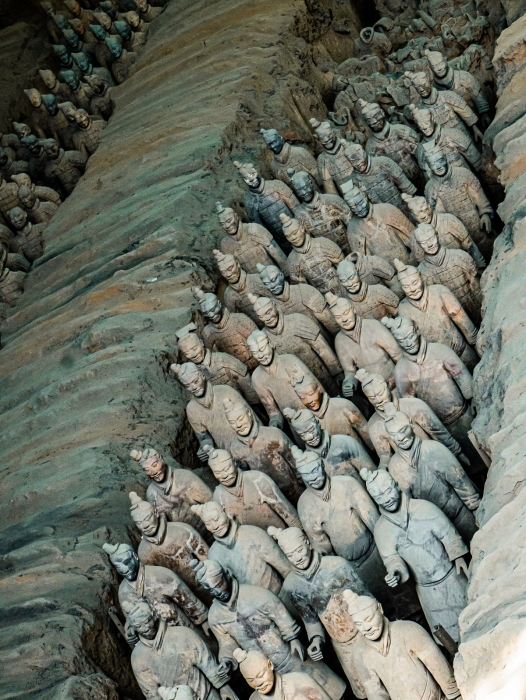
In 1974 farmers were digging a well outside of the city of Xi’an when they came across an astonishing find. It was a life-sized clay soldier poised ready for battle. The find was reported to the authorities, and since all land in China belongs to the government, the land in the area was immediately seized. Thus began one of the biggest archaeological digs of all time, revealing one of the greatest historical discoveries in the world.
The people of the area were displaced and new housing built for them. They were not happy about losing their farms, and there was a generation in there that really struggled. These days the income of the area is robust due to the thousands of domestic and foreign tourists who come to see one of the most extraordinary creations of the ancient world. Swings and roundabouts, but the word is that when developers find any indications of ancient China (and apparently this is not infrequent) they don’t report it because they don’t want the land they are building on confiscated.
Talking of swings and roundabouts – Emperor Qin standardized coins, weights, and measures throughout China. Under his rule the states were connected with canals and roads, and he is credited with building the first version of the Great Wall. But by all accounts he was also a cruel dictator.
Slowly I make my way around the balcony that overlooks the pit from all sides. Each life-sized figure is unique, their clothing and hairstyle signifying rank.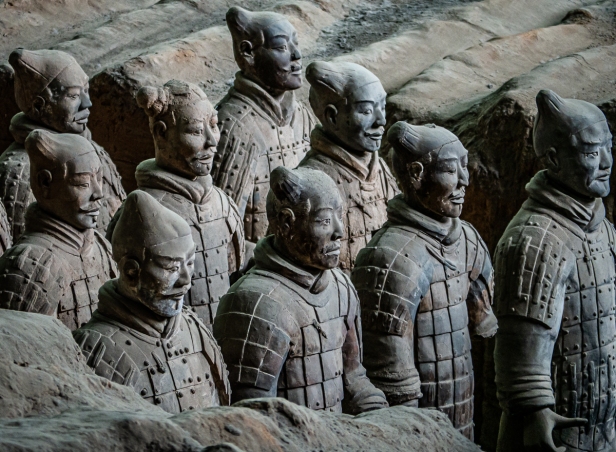
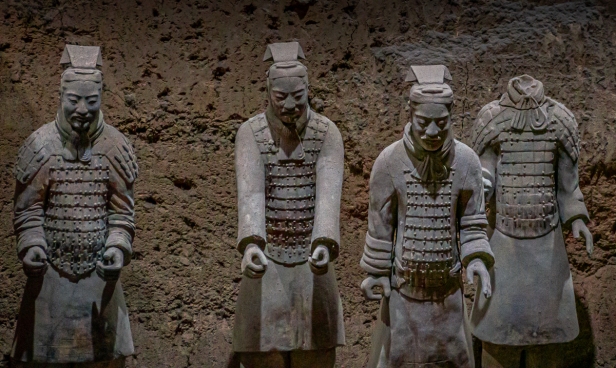
There are hundreds of them. They are lined up three-deep across the front of the enclosure,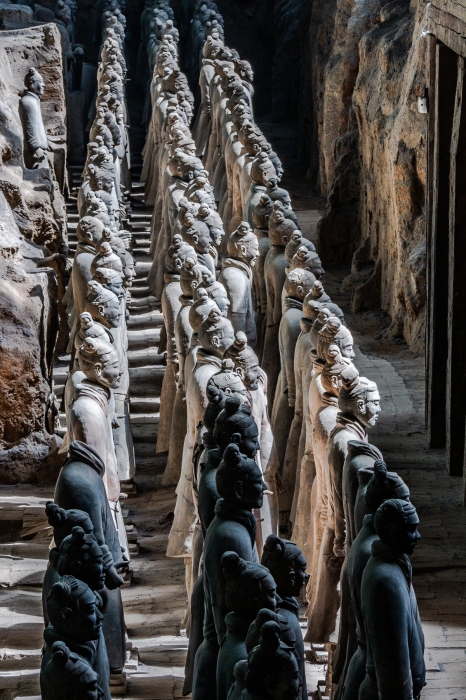
and beyond this vanguard are row upon row of soldiers, vanishing far down the hall into the trenches from which they were unearthed. I stare and stare at them, taking in the detail. Every face is different. Every one. It’s as if they were made from life.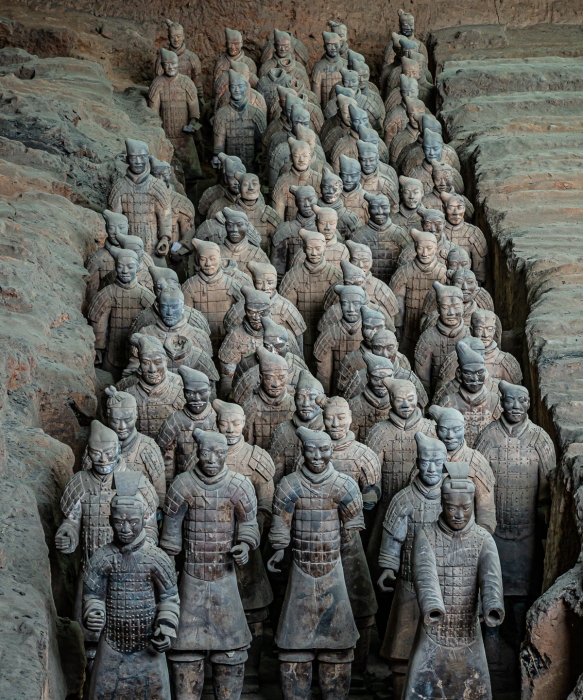
There are horses four-abreast with their soldiers,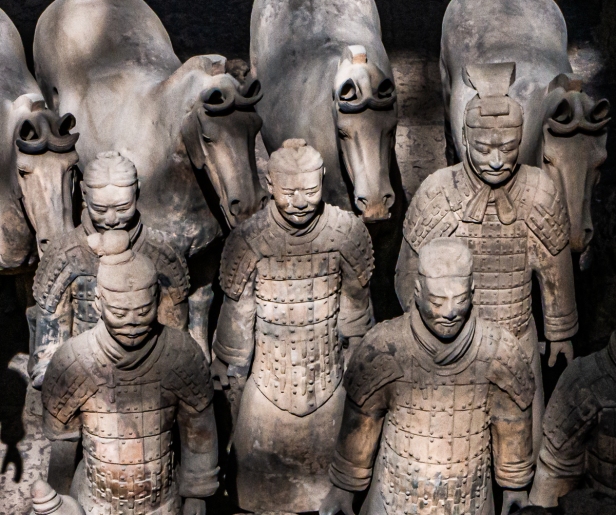
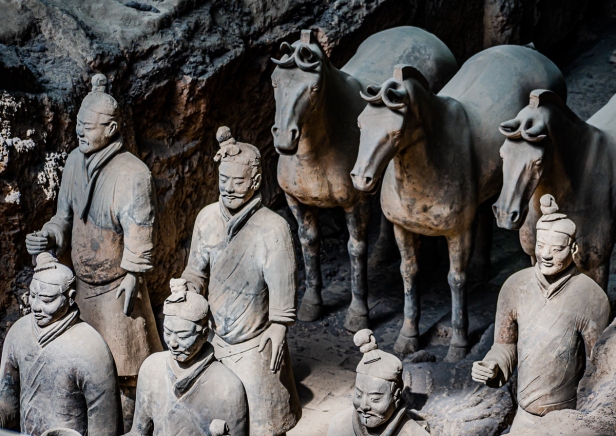
and in other pits there are chariots, weaponry, drums, concubines, as well as acrobats, dancers and musicians caught mid-performance, and much more. It is estimated that there are more than 8,000 soldiers, with 520 chariot horses and 150 cavalry horses, all made from clay, as well as 130 wooden chariots. The majority of them are still buried. The entire necropolis, which includes Qin’s tomb, is estimated to cover 98 square kilometres and is a microcosm of the emperor’s imperial court.
The tomb remains unopened, in part because of the fear of disintegration on contact with the air. The soldiers were originally painted in bight colours, red, green, blue, in great detail, but when they are unearthed the paint flakes off within minutes. Apparently some German scientists have figured out a way to preserve the paint as the soldiers are dug up but will only give the secret to the Chinese in exchange for some of the warriors moving to Germany. The Chinese government refused the offer.
As I continue my journey along the balcony overlooking this main pit I try to imagine the soldiers painted in the bright colours they would have originally worn back in 210BCE. How glorious they must have looked, battalion upon battalion ready to defend the emperor.
At the back of the hall the archaeologists are hard at work,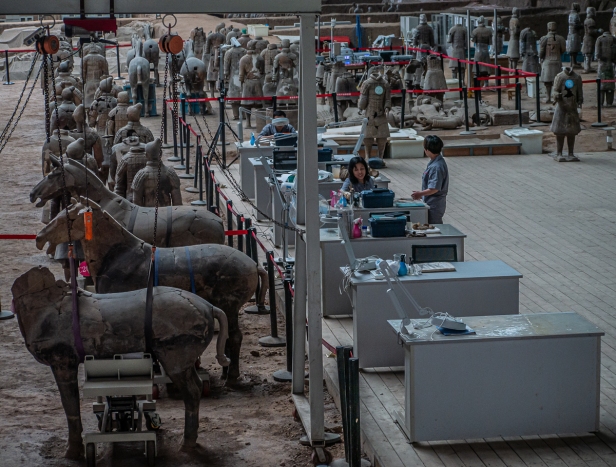
slowly digging broken pieces from the trenches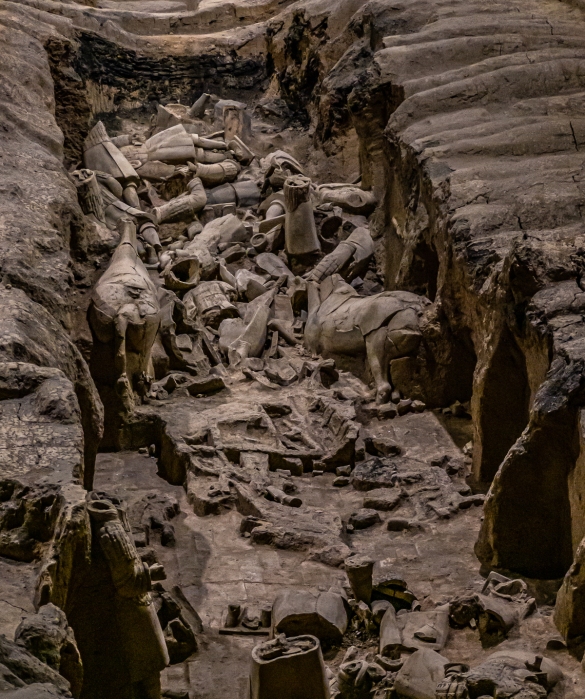
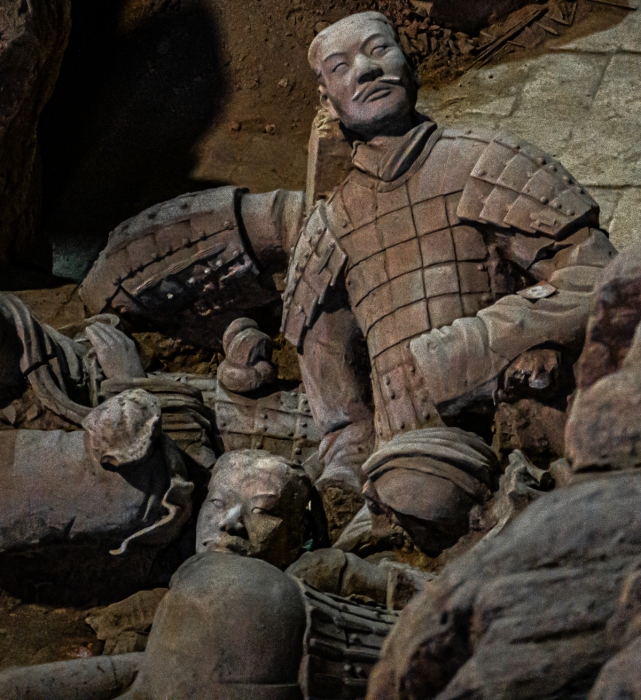
and piecing together fragments to create complete statues.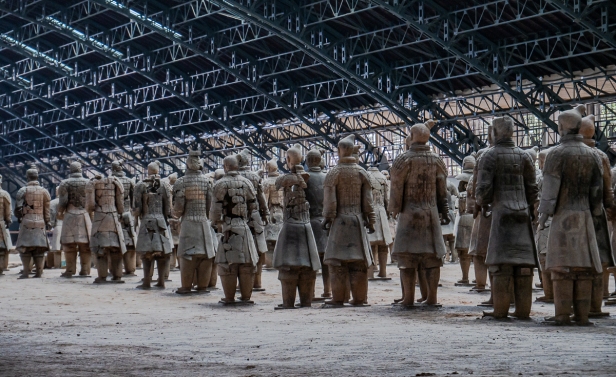
In another building there are perfect specimens on display: a kneeling archer (one of 160 that have been found),
a high-ranking officer,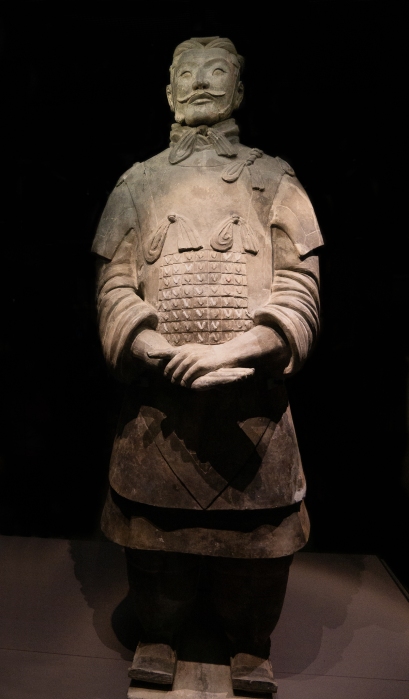
and a cavalry officer with his horse (one of 116 that have been found).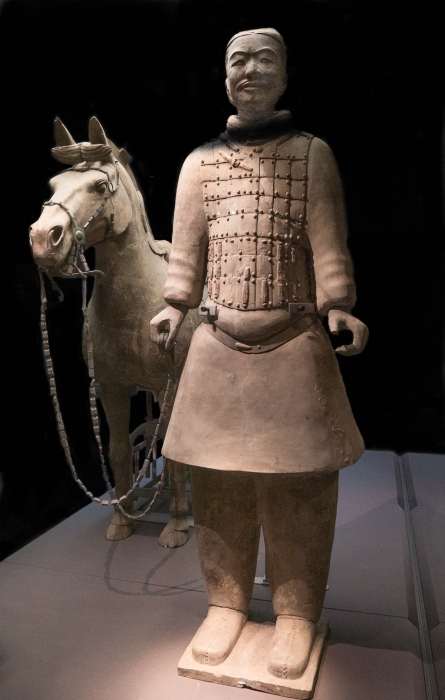
A painstaking five years was needed to put together the two bronze chariots found near Qin’s tomb. For over two thousand years they lay in a box buried in a trench eight metres (26ft) underground. It is believed they were intended for Emperor Qin to use them for inspection tours in the afterlife. They are exactly half-size replicas of the originals, constructed in bronze and cast bullion, and complete with a team of four bronze horses and a coachman, and about fourteen kilos (30 lbs) weight of gold and silver pieces. The carriages alone have about 3,400 parts each. Like the army they would have originally been painted in bright colours.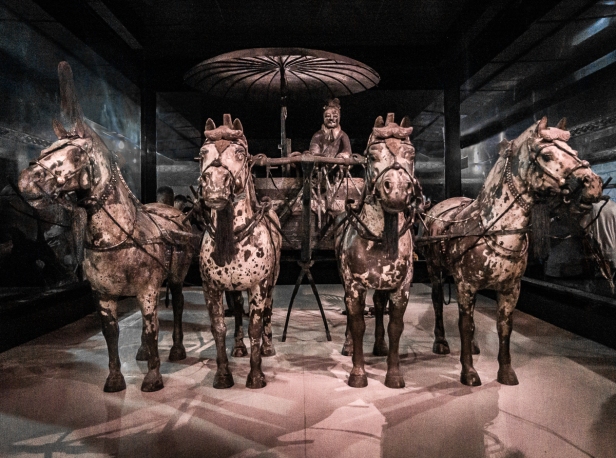
There is large hill close to where the warriors are located that is known to be Qin’s unopened tomb. Historical reports written 100 years after his death, and modern probing techniques, indicate that the tomb is a magnificent place with bronze mountains, rivers of mercury, precious jewels and pearls representing heavenly bodies in a dark blue firmament, birds of gold and silver, palm trees of jade, fine vessels, and rarities. There are models of palaces and pavilions: everything the emperor could need or wish for. It is reportedly a vast underground palace that took 700,000 conscripted workers 36 years to complete.
The scale of the whole mausoleum is barely comprehensible: 8000 soldiers and their weapons, hundreds of clay horses, human skeletons (likely the emperor’s children), horse skeletons, the bronze chariots and horses, many artefacts, hundreds of clay concubines, performers, musicians, and even a zoo for exotic animals!
What we see, in this extraordinary place, is simply a taste. By a long shot most of it is still buried and will probably remain so. The treasures of the past, the work of thousands upon thousands of artisans, will likely remain hidden in their original burial place.
Seeing all that has been unearthed, and now researching and writing about it, I am again bewildered by this preoccupation with the afterlife as if it’s some otherworldly continuation of the present life. It was the same with the Egyptian pharaohs, King Tutankhamen being the most obvious example. What were they thinking? Did they seriously believe they could take it all with them? I guess so.
Next post: either some stories from Xi’an – China’s capital for nearly 2000 years, or something about the food!
All words and images by Alison Louise Armstrong unless otherwise noted
© Alison Louise Armstrong and Adventures in Wonderland – a pilgrimage of the heart, 2010-2019.

So mesmerising. I learnt about the Terracotta Army at uni and I find it so fascinating. The scale of this mausoleum is so immense.
LikeLiked by 1 person
Thanks so much San. It’s one of the most amazing places I’ve been to, if only for the scale of it all. Just astounding. I’m so glad I got to see it.
Alison
LikeLiked by 1 person
I’ve seen pictures before, but they didn’t really show the space and the amount of statues. Thanks for capturing this for us.
LikeLiked by 1 person
Thanks Rabirius, and you’re welcome. I was completely blown away by it. The whole complex is so huge. The hall shown is the biggest, but there are two other halls (or pits) that are open to the public. In the interests of brevity I conflated them here.
Alison
LikeLike
It’s an incredible site and your description and photos really bring it to life.
LikeLiked by 1 person
Thanks so much Peggy. Incredible indeed.
Alison
LikeLike
Fantastic! I was lucky enough to see this with my own eyes and your post took me back there. Looking forward to more adventures from Xi’an!
LikeLiked by 1 person
Thanks David. Glad I brought back some good memories for you. Isn’t it an extraordinary place?!
Alison
LikeLiked by 1 person
I saw an exhbit of the Terra Cotta Warriors at Seattle Center a couple years ago. Much fewer figures than this, of course, but still very impressive. This huge display must have been so awesome – “jaw dropping”, as you describe it.
LikeLiked by 1 person
Definitely jaw dropping! I had no idea what to expect. I’d only ever seen pictures of a few of them but never of the whole collection.
Alison
LikeLike
Your photos are among some of the best I have seen of this remarkable hall of soldiers.
An amazing feat and something I will never see in person, but your post certainly brings the story and figures to life.
I still can’t get over the fact that every facial expression is unique and like no other soldier (that they’ve excavated so far).
LikeLiked by 1 person
Thank you so much Vicki. It’s an astonishingly remarkable place! Every time I even think of it I’m blown away by both the detail, and the enormity of it.
I’m glad I was able to bring you a virtual experience of it.
Alison
LikeLiked by 1 person
impressive expression
of that army,
which in of itself
is most impressive! 🙂
LikeLiked by 1 person
Thank you David.
It is definitely
a most impressive
place.
More than I could
have imagined.
Alison
LikeLike
I enjoyed reading this post, especially because it is one of the places I never managed to visit whilst in China. Love the background and history you have added to your piece. Very interesting.
Lieve
LikeLiked by 1 person
Thanks Lieve. I’m glad you enjoyed it. It was truly amazing. Too bad you didn’t get to go there. In the future maybe?
Alison
LikeLike
Not entirely sure … Would love to, but having left China in rather unorthodox fashion, I am not sure whether I should try to re-enter, even as a tourist. But if the opportunity comes up – and I feel I can risk it – there are still so many part of China I had set my sights on… Such a vast country takes a lot of time to explore.
Lieve
LikeLiked by 1 person
I have read that it’s not possible to get close to the terracotta warriors, but your photos are fantastic. I saw the exhibition in London a few years ago, when it was possible to get really close and see detail, but then of course, what was missing, was the huge scale of the thing. Your post made me feel how astounding it really is.
LikeLiked by 1 person
Thanks Tracey. It really is astounding. You can’t get close, as in not right up next to them, but you certainly get a pretty good view from the balcony surrounding the pit. I was able to get the photos with only a small zoom. And, yeah, the scale! It’s enormous and only a fraction of it is visible. Still gob-smacked just thinking about it.
Alison
LikeLike
What an awe-inspiring work of art. The history of China is so intricate and vast. And intimidating! Where to even start? Thanks for sharing this piece of it.
LikeLiked by 1 person
You’re welcome JD. I knew nothing about Chinese history until I started researching for this post and earlier posts for my blog. You’re right – the history is intricate and vast. And yes, intimidating! Just for this piece – I gave the bare outline of the back-story. Yiren for instance has two or three other names. All the emperor’s do. One you start looking it’s like falling down a (very complex) rabbit hole.
Alison
LikeLike
Astonishing! Your photos really bring home the immensity of the mausoleum. I’ve never seen anything like this before. Completely mind-blowing!
LikeLiked by 1 person
Thanks Isabella. I’d certainly never seen anything like it! I’m still blown away just thinking about it, and also trying to fathom the mindset of that era – that they would do such a thing. I find it fascinating and bizarre and astonishing.
Alison
LikeLiked by 1 person
Since I piqued my interest in China, Xi’an has always been high on my wishlist of places I want to see in the country. The scale is incomprehensible, the details exquisite, and the variations incredible. I can imagine having goosebumps when I see these terracotta warriors myself one day.
LikeLiked by 1 person
Oh I do hope you get there one day Bama. It really is extraordinary. As you say – incomprehensible scale and exquisite detail, and the whole concept beyond fathoming.
Alison
LikeLiked by 1 person
The sheer scale of the archaeological find is mind boggling. It seems that no matter what the topic, when it comes to China, size or quantity often eclipses similar events in other countries.
What is so fascinating is not, to me, the Emperors fascination with the afterlife, but the ability to sustain a vision to create this mausoleum that is so large and that must have required the work and talent of such a large population of artists. Just the logistical aspect of the housing and the feeding of the workforce, then the baking process which typically breaks a percentage of the work…. And to think most of it is still buried!
Thanks for your sharing your wonderful photos.
Ben
LikeLiked by 1 person
Yes, I’d certainly noticed that – that size and/or quantity in China is beyond anything found anywhere else. We went to another imperial mausoleum almost equally impressive that had thousands upon thousands of clay figures. And China has more high-speed rail track than all the rest of the world put together. And the Forbidden City is the largest palatial structure in the world, and so the list goes on and on. It’s quite mind-boggling to see it. The battalions of high-rises, and the speed with which entire new cities appear. Sometimes it’s hard to believe.
I too think about what (and who) it took to creates Qin’s mausoleum – 700,000 workers (probably slaves really) – but someone(s) had to be in charge, have the vision as you say and to keep it on track for what 40 years, something like that. It reminded me that the workers that built the the tombs for the kings of Egypt had their own village near the Valley of the Kings. They all lived together there with their families. I would imagine that once you were assigned to the building of one of the tomb it would be a lifetime job. They were of course the first grave robbers since they were the ones who knew what was in there 🙂
Alison
LikeLike
The Terra Cotta Warriors are probably the most underappreciated wonder of the world because as you say, most of it is buried and will remain so. If all of this was out in the open it would be even more mind-blowing than it is.
LikeLiked by 1 person
Oh Jeff, believe me it is quite mind-blowing enough as it is. There is so much that is uncovered, so much to see.
I think the issue may be that seeing a few in an exhibition doesn’t give an inkling of the scale of it. It was only by going there and walking into that three-acre enclosure that I got it.
But I must say I’m hoping the Chinese scientists will figure out how to save the paint. I’m sure if they do then more will be dug up, and preserved in their original bright colours. I’d love to see that.
It’s unlikely they’ll open the tomb because of the high levels of mercury detected in the area.
Alison
LikeLike
Absolutely amazing Alison. I can only imagine the scale of seeing this in person! Wow!
LikeLiked by 1 person
Thanks Nicole. In person it was beyond anything I could have imagined. I doubt I’ll ever forget it. I didn’t really understand what all the fuss was about until I walked into that enclosure and saw it for myself.
Alison
LikeLiked by 1 person
This is the first time I’ve read about this site in such detail and it’s absolutely fascinating. The scale blows me away. I also had no idea that this was unearthed relatively recently. Amazing account and photos Alison.
LikeLiked by 1 person
Thanks so much Caroline. I didn’t know much about it at all when I went there and was totally gobsmacked. I had no idea! I’d seen photos of individual warriors, but the whole excavation is barely comprehensible. I’m glad you enjoyed it, it was fun to research and share because it’s so completely over the top.
Alison
LikeLike
Best explain & enjoy reading a lot..!!!
LikeLiked by 1 person
Thank you so much. I’m glad you enjoyed it.
Alison
LikeLike
Wow! I’ve seen a few photos before, but you have really done a great job of photographing and explaining the history. I am amazed but also sad about the insanity of powerful men, trying to imortalize themselves! Hopefully the artisans were treated well for their life’s work.
LikeLiked by 1 person
Thanks so much Michael. It was a truly extraordinary thing to see. I was blown away by it, so it was pretty fascinating to do the research. Ah yes, the insanity of powerful men. I do think insanity is the right word, and I highly doubt that the workers would have been treated well unfortunately.
Alison
LikeLiked by 1 person
Great job with the history (and of course the photos), Alison! I visited Xi’an and the warriors in 2009 and, like you, I doubt I’ll ever forget it. In fact, I brought back a number of replicas for myself and others (very unlike me) because I found the figures so intriguing. I think I was most blown away by the finding of the field full of treasures in the first place and then the painstaking amount of work that goes into extricating and rebuilding the statues. Fantastic post!
P.S. I also loved Xi’an for its dumplings and its city wall! It’s one of the places I would definitely be up for visiting again.
LikeLiked by 1 person
Thanks so much Lexie. Like you I was blown away by both the scale and by the detail. Truly amazing. I’m still blown away just thinking about it! Imagine finding such a thing?!
I too loved Xi’an (more to come on that), but not the dumplings so much – at least not the ones were we went to a very touristy place for dinner and were served 16 different types of dumplings, all of them IMO underdone 😦 – just a bit too chewy for my taste.
Alison
LikeLiked by 1 person
As you typically do, you have brought just the right amount (in my view) of feeling and personal reaction into the post. It’s plenty of information and it’s pleasant to read, but beyond that, I get a taste of how you reacted, how it moved you, which is not how the next person will be moved. And what a moving experience seeing this place was!
LikeLiked by 1 person
Thank you so much Lynn. I really appreciate your comment as I think personal feeling and reaction to a place is as important to the bare facts, or maybe even more so. I do try to keep things interesting 🙂
It was an incredibly moving experience. I was completely bowled over by it.
Alison
LikeLike
Astonishing! Your photos really bring home the immensity of the mausoleum. I’ve never seen anything like this before. Completely mind-blowing!
LikeLiked by 1 person
Thank you so much. I’ve never seen anything like it before either. I’m still totally amazed even thinking about it. I knew it existed but had absolutely no idea of the scale. It’s extraordinary in every way. I’m glad I’ve managed to capture even a little bit of the feel of that.
Alison
LikeLike
What an unbelievable story! Imagine digging for a well and uncovering that.
LikeLiked by 1 person
Isn’t it?! Even thinking about it later I’m blown away. It was so amazing to see it in person. I really had no idea.
Alison
LikeLike
Great post as always, Alison. Uwe saw the terracotta army about 30 years ago, before it became a world-wide must-see sensation. The site was hard to reach and relatively quiet. He returned with me, decades later – and we visited during Golden Week. Everyone in China was on vacation. The crowds were as thick as the terracotta figures! But what an incredible monument!!
LikeLiked by 1 person
Thanks so much Jadi. The crowds were huge when I was there so I can’t even imagine what it must have been like during Golden Week, but yes, a truly impressive monument.
By the way I’ve tried several times to comment on your latest post and I’m still getting the same thing I told you about before – a download that says: The server is temporarily unable to service your request due to maintenance downtime or capacity problems. Please try again later.
My comment was that I can’t wait for the next installment!
Alison
LikeLike
This is on my list of things to see. But if for some reason I don’t get to see it, your post, pictures and descriptions, will do. Amazing. Thanks so much.
LikeLiked by 1 person
Thank you! And you’re welcome. It was a pleasure to put this post together – the whole thing is so completely mind-boggling!
I hope you get there one day. It really is amazing.
Alison
LikeLiked by 1 person
Hello is any here that can help to get a visa to travel and work please
LikeLiked by 1 person
I’m sorry I am unable to do that.
Alison
LikeLike